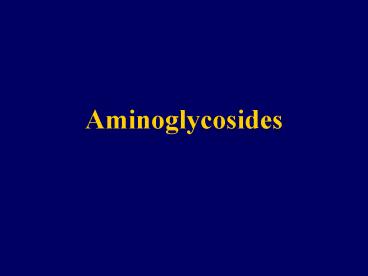Aminoglycosides - PowerPoint PPT Presentation
1 / 25
Title:
Aminoglycosides
Description:
Severe Gram negative bacterial infections due to susceptible ... Bacterial gastroenteritis. LRTI. Sinusitis. Skin and soft tissue. Bone and joint. Bacteremia ... – PowerPoint PPT presentation
Number of Views:254
Avg rating:3.0/5.0
Title: Aminoglycosides
1
Aminoglycosides
2
Aminoglycosides
- Streptomycin Gentamicin
- Spectinomycin Tobramycin
- Neomycin Amikacin
- Paramomycin Netilmicin
- Kanamycin Sisomicin
- Not available in U.S.
3
Description
- Natural and semisynthetic compounds derived from
Streptomyces spp. (-mycins) and Micromonospora
spp. (-micins). - Six membered amino-group-containing ring,
aminocyclitol, that is linked to one or two
sugars.
4
Antimicrobial Activity
- Many aerobic gram negative bacteria including
most Enterobacteriaceae, Pseudomonas sp.,
Yersinia sp., Brucella sp. - Staphylococcus aureus, Enterococcus sp.
- Many mycobacteria , including M. tuberculosis
- Highly variable activity between different
hospitals and geographic locations - Generally inactive vs. anaerobic bacteria
5
Mechanism of Action
- Inhibition of protein synthesis through
irreversible binding to 30s ribosome leading to
synthesis of mistranslated proteins. - Direct damage to the outer cell membrane.
- Exact mechanism of action not fully elucidated.
6
Pharmacokinetics
- Given i.v. or i.m., through i.v. preferred
- Poorly absorbed p.o.
- Weakly protein bound, freely distributes into
interstitial and extra cellular fluid - Tissue/body fluid levels are less than serum
levels except for kidneys, per lymph of the inner
ear, and urine - Poor CNS penetration in normal circumstances
- Eliminated unchanged through urine
- Removed by hemodialysis peritoneal dialysis
7
(No Transcript)
8
(No Transcript)
9
Pharmacodynamics
- Concentration-dependant bacteriocidal activity
- Post-antibiotic effect
- Immunomodulation
- AUC/MIC
- Peak MIC
10
Mechanisms of Resistance
- Decreased uptake (intrinsic vs. acquired)
- Ribosomal target modification
- Aminoglycoside-modifying enzymes
- acetyltransferases
- adenyltransferases
- phosphotransferases
11
Toxicity
- Neuromuscular brockade (reversible)
- - rapid infusion
- - increase risk with neuromuscular blockers
- - myasthesia gravis
- - reversible with calcium gluconate
- Ototoxicity (irreversible)
- - vestibular
- - auditory (high frequency)
- Nephrotoxicity (usually reversible)
- - proximal tubular cell necrosis
12
Risk Factors for Nephrotoxicity
- Multiple dose regimen
- Advanced age
- Pre-existing renal function
- Hypovolemia
- Shock
- Liver dysfunction
- Obesity
- Length of therapy
- Nephrotoxic agents (e.g. cyclosporine,
amphotericin B, furosemide)
13
Dosing Regimens for Aminoglycosides
- Multiple daily dosing
- Single daily dose
- Dosing according to renal function
14
Clinical Uses of Specific Aminoglycosides
- Gentamicin, Tobramicin, Amikacin
- - Serious gram negative bacillary infections
- Streptomycin
- - Antituberculous therapy
- Neomycin
- - Topical (cutaneous) therapy
- - Bowel decontamination
- Paromomycin
- - Oral therapy for Cryptosporidium and
- E. histolytica intestinal infections
15
Clinical Indications
- Severe Gram negative bacterial infections due to
susceptible organisms - Febrile neutropenia
- Serious S. aureus infections
- Enterococcal endocarditis
- Viridans streptococcal endocarditis
- Prosthetic valve endocarditis
- Mycobacterial infections
In combination with a B-lactam or vancomycin
16
Fluoroquinolones
17
(No Transcript)
18
Mechanisms of Action
- DNA gyrase inhibition
- Rapidly bacteriocidal
- Significant post-antibiotic effect
19
Mechanisms of Resistance
- Alternations in DNA gyrase leading to decreased
drug binding - Alternations in other membrane protein
- leading to decreased intracellular drug
accumulation
20
Adverse Events
- Gastrointestinal 3-13
- CNS 1-7
- Skin 1-11
- Allergic 1-2
- Hepatic 1-3
- Hematologic lt1
- Overall 5-20
21
Drug Interactions
Decreased absorption - Aluminum and
magnesium containing compounds (including
sucralfate) - Ferrous sulfate Delayed
absorption - H2blockers - Food Other -
Theophylline levels (enox, cipro) -
Cyclosporine?
22
(No Transcript)
23
Antimicrobial Activity of Fluoroquinolones
- Enterobacterialeae (all)
- Legionella sp.
- Fastidious GNRs (all)
- P. aeruginosa (Cipro)
- Methicillin-sensitive S. aureus
- Streptococci (Cipro, Oflox, Levo, Spar)
- PRSP (Spar, Levo)
- Anaerobes (Levo, Spar)
- Chlamydia sp. (Oflox, Levo)
- Mycobacteria sp. (Oflox, Levo, Cipro)
All lack significant activity vs. Enterococcus
sp., Listeria, Nocardia sp.
24
(No Transcript)
25
Clinical Uses
- Uncomplicated UTIs
- Complicated UTIs
- Prostatitis
- STDs
- Bacterial gastroenteritis
- LRTI
- Sinusitis
- Skin and soft tissue
- Bone and joint
- Bacteremia
- Complicated nosocomial infections































